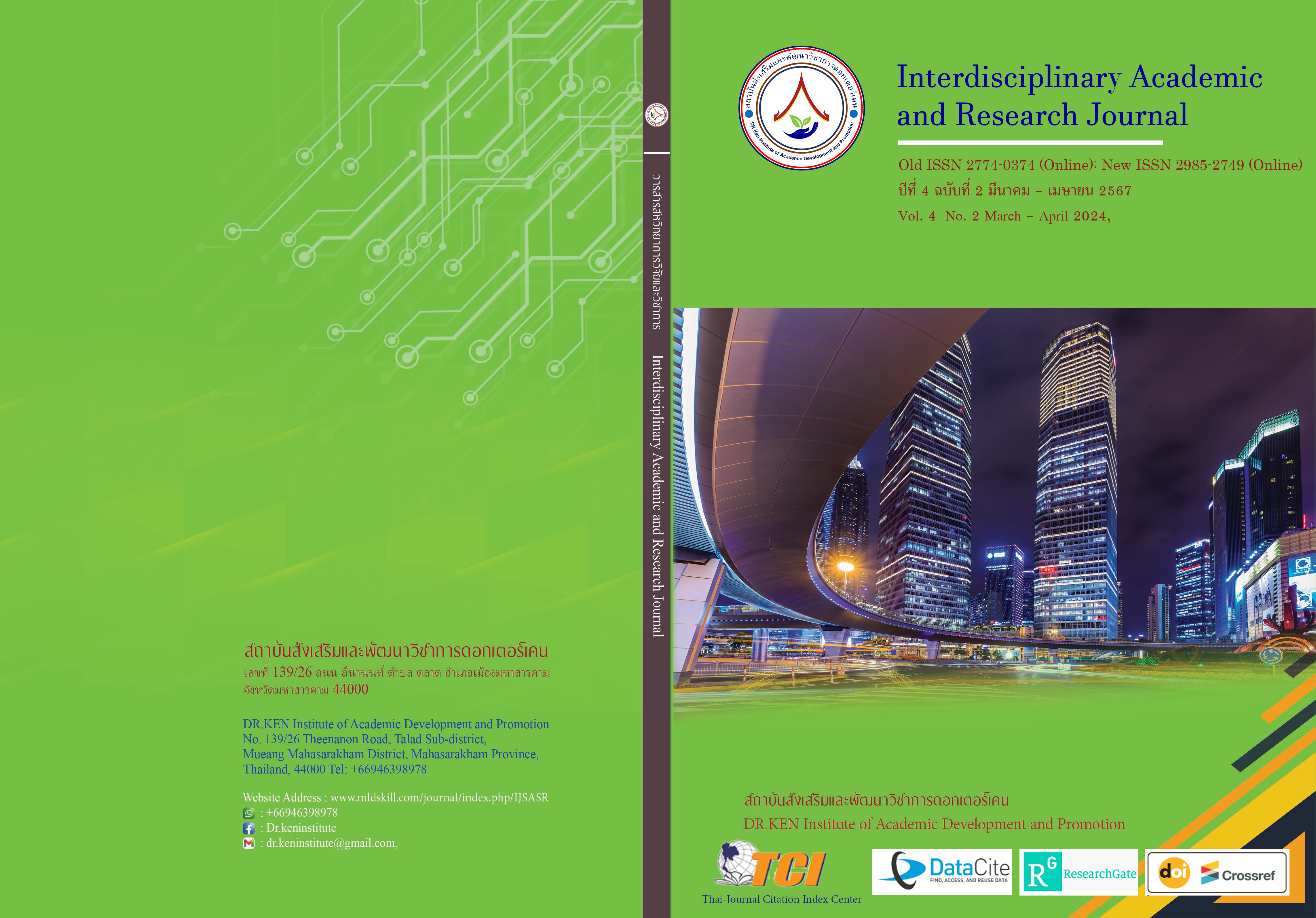The Guidelines for Development of the Organizational Health of Schools Under the Kalasin Primary Educational Service Area Office 2
DOI:
https://doi.org/10.60027/iarj.2024.274645Keywords:
Guidelines for Development; , Organizational Health;, SchoolsAbstract
Background and Aims: The organizational health of schools was conditions of operations according to the mission of schools. schools can survive and develop continuously, problem-solving, smooth internal administrative processes, and no stress. Therefore, this research aims to study the current state, the desirable state, and the priority needs and study the guidelines for the development of the organizational health of schools under the Kalasin primary educational service area office 2.
Methodology: The research is divided into 2 phases: Phase 1 studies the current state, desirable state, and priority needs of development and the organizational health of schools, A sample group of 278 school administrators and teachers, was randomly selected using a stratified sampling method. The research instrument is a questionnaire with a 5-level with a confidence value of 0.81 and data analysis by mean and standard deviation. phase 2 study of the guidelines for the development of the organizational health of schools. The target group comprises 3 best practice schools and 9 experts for assessment of the development guideline. The research instrument was a semi-structured interview form and assessment form the suitability and feasibility of development guidelines.
Results: The current state overall was moderate level, and the desirable state overall was at the highest level. The priority needs ranked from high to low level were teacher friendliness, colleague leadership, morale, communication, and resource utilization respectively. The development guideline of organizational health of schools under the Kalasin primary educational service area office 2 was a method for developing using a manual consisting of 1) principles and reasons 2) objectives, 3) content 4) development methods 5) measurement and evaluation. The development guidelines are divided into 6 learning units: 1) resource utilization, 2) teacher friendliness, 3) communication, 4) morale 5) colleague leadership. The results of the evaluation of the suitability and feasibility of development guidelines overall were at the highest level.
Conclusion: Organizational health Organizational health is important for schools, administrators, teachers, educational personnel, and students. Because of the quality and efficiency in schools organization on the organizational health. Organizational health consists of factors, resource utilization, teacher friendliness, communication, morale, and colleague leadership.
References
กมลทิพย์ ใจเที่ยง. (2562). การบริหารองค์กรแห่งความสุขในโรงเรียนประถมศึกษา. วิทยานิพนธ์ปรัชญาดุษฎีบัณฑิต (การบริหารการศึกษา): มหาวิทยาลัยศิลปากร.
กษมา ช่วยยิ้ม. (2563). ศึกษาการพัฒนารูปแบบการสร้างความสุขในการทำงานของผู้บริหารและครูในสถานศึกษาสังกัดสำนักงานเขตพื้นที่การศึกษาประถมศึกษาสุราษฎร์ธานี เขต 2. วิทยานิพนธ์ครุศาสตรมหาบัณฑิต: มหาวิทยาลัยราชภัฏสุราษฎร์ธานี.
กอบกุล วิศิษฏ์สรศักดิ์. (2558). สุขภาพองค์การกับการประกันคุณภาพการศึกษาภายในของคณะมนุษยศาสตร์และสังคมศาสตร์ มหาวิทยาลัยราชภัฏเพชรบุรี. มหาวิทยาลัยราชภัฏเพชรบุรี.
จิราวัฒน์ ไทยประเสริฐ. (2559). ความสัมพันธ์ระหว่างสุขภาพองค์การ ความสุขในการทำงาน และความผูกพันในงาน กรณีศึกษา :พนักงานธนาคารแห่งหนึ่งในกรุงเทพมหานคร. การศึกษาค้นคว้าอิสระศิลปศาสตร์มหาบัณฑิต: มหาวิทยาลัยธรรมศาสตร์.
ณัฎฐ์ธนิน โพธิ์พ่วง. (2558). สุขภาพองค์การของโรงเรียนมัธยมศึกษาจังหวัดอุทัยธานี สังกัดสำนักงานเขตพื้นที่การศึกษามัธยมศึกษา เขต 42. วิทยานิพนธ์การศึกษามหาบัณฑิต (การบริหารการศึกษา): มหาวิทยาลัยบูรพา.
ธร สุนทรายุทธ. (2551). การบริหารจัดการเชิงปฏิรูป : ทฤษฎี วิจัย และปฏิบัติทางการศึกษา. กรุงเทพฯ : บริษัทเนติกุลการพิมพ์ จำกัด .
ธัชชัย จิตรนันท์. (2557). ปัจจัยที่มีอิทธิพลต่อสุขภาพองค์การของสถานศึกษาในเขตจังหวัดภาคตะวันออก เฉียงเหนือ. วารสารมนุษยศาสตร์และสังคมศาสตร์มหาวิทยาลัยมหาสารคาม. 33 (1), 96-105.
นันท์มนัส รอดทัศนา. (2554). การจัดทำคู่มือจัดกิจกรรมพัฒนาความมีวินัยของนักเรียนชั้นประถมศึกษาปีที่ 6 โรงเรียนสารสาสน์วิเทศบางบอน. วิทยานิพนธ์การศึกษามหาบัณฑิต: มหาวิทยาลัยศรีนครินทรวิโรฒ.
นัยนา สุนะเสน. (2564). สุขภาพองค์การของศูนย์พัฒนาเด็กเล็ก สังกัดองค์กรปกครองส่วนท้องถิ่นอำเภอแจ้ห่ม จังหวัดลำปาง. การศึกษาค้นคว้าอิสระการศึกษามหาบัณฑิต (การบริหารการศึกษา): มหาวิทยาลัยพะเยา.
บุญชม ศรีสะอาด. (2556). การวิจัยเบื้องต้น. (พิมพ์ครั้งที่ 9). กรุงเทพฯ : สุวีริยาสาส์น.
ประสิทธิ์ อุ่นหนองกุง. (2559). รูปแบบการพัฒนาภาวะผู้นำทางวิชาการของผู้บริหารโรงเรียนพระปริยัติธรรม แผนกสามัญศึกษา ภาคตะวันออกเฉียงเหนือ. วิทยานิพนธ์ครุศาสตรดุษฎีบัณฑิต: มหาวิทยาลัยราชภัฏสกลนคร.
พัชรพร สันติวิจิตรกุล. (2553). การพัฒนาคู่มือวิจัยในชั้นเรียนสำหรับครูผู้สอนในโรงเรียนองค์การบริหารส่วนจังหวัดสุราษฎร์ 1 (ดอนสักผดุงวิทย์). วิทยานิพนธ์ครุศาสตรมหาบัณฑิต (การบริหารการศึกษา): มหาวิทยาลัยราชภัฏสุราษฎร์ธานี.
ไพศาล วรคำ. (2559). การวิจัยทางการศึกษา. พิมพ์ครั้งที่ 8. มหาสารคาม : ตักสิลาการพิมพ์.
เรวัตร งะบุรงค์. (2558). ปัจจัยที่ส่งผลต่อสุขภาพองค์การของสถานศึกษาสังกัดสำนักงานเขตพื้นที่การศึกษานครนายก. วิทยานิพนธ์การศึกษามหาบัณฑิต: มหาวิทยาลัยเทคโนโลยีราชมงคลธัญบุรี นครนายก.
เรืองชัย จรุงศิรวัฒน์. (2554). เทคนิคการเขียนคู่มือปฏิบัติงาน. ขอนแก่น : สำนักงานอธิการบดี มหาวิทยาลัยขอนแก่น.
สำนักงานเขตพื้นที่การศึกษาประถมศึกษากาฬสินธุ์ เขต 2. (2566). รายงานผลการปฏิบัติราชการประจำปีงบประมาณ 2566. กลุ่มนโยบายและแผน สำนักงานเขตพื้นที่การศึกษาประถมศึกษากาฬสินธุ์ เขต 2.
สำนักงานคณะกรรมการการศึกษาขั้นพื้นฐาน. (2562). การพัฒนาข้าราชการครูและบุคลากรทางการศึกษาก่อนแต่งตั้งให้ดำรงตำแหน่งผู้อำนวยการสถานศึกษา. กรุงเทพฯ : สำนักพัฒนาระบบบริหารงานบุคคลและนิติการ.
สำนักงานคณะกรรมการพัฒนาการเศรษฐกิจและสังคมแห่งชาติ. (2563). แผนปฏิรูปประเทศ. (พิมพ์ครั้งที่ 3). กรุงเทพฯ: สำนักงานเลขานุการของคณะกรรมการยุทธศาสตร์ชาติ.
สุวิมล ว่องวาณิช. (2558). การวิจัยประเมินความต้องการจำเป็น. กรุงเทพฯ: สานักพิมพ์แห่งจุฬาลงกรณ์มหาวิทยาลัย.
อัญชิษฐา ตนภู. (2559). สุขภาพองค์การของโรงเรียนมัธยมศึกษาในอำเภอแม่สายจังหวัดเชียงราย. การศึกษาค้นคว้าด้วยตนเองการศึกษามหาบัณฑิต: มหาวิทยาลัยพะเยา.
Cronbach, L.J. (1970). Essentials of Psychological Testing. 3rd edition. New York: Harper. And Row.
Hersey, P., & Blanchard. K.H. (1993). Management of Organizational Behavior: Utilizing. Human Resources. 6th edition. Englewood Cliffs, NJ: Prentice Hall.
Hoy, K.W., & Miskel, G.C. (2005). Education Administration Theory Research and Practice. 7th edition, Singapore: McGraw-Hall.Inc.
Hoy, W. K., & Feldman, J.A. (1987). Effective Supervision: Theory into Practice. New York: McGraw-Hill.
Hoy, W.K., & Feldman, J.A. (1996). Organizational health: The concept and its measure, Journal of Research and Development in Education, 20(4), 30-37.
Hoy, W.K., & Miskel, C.G. (1991). Educational Administration Theory, Research, and Practice. 3rd edition. New York: Random House
Hoy, W.K., & Sabo, D. (1997). Quality Middle Schools: Open and Healthy. California: Corwin Press, Inc.
Hoy, W.K., and Miskel, C.G. (2001). Educational Administration: Theory, Research, and Practice. 6th ed. New York: McGraw-Hill.
Krejcie, R.V., & Morgan, D.W. (1970). Determining Sample Size for Research Activities. Educational and Psychological Measurement, 30(3), 607-610.
Miles, M.B. (1973). Planned Change and Organization Health: Figure and Ground. Education Administration and Behavioral Science: A Systems Perspective. Boston: Allyn & Bacon.
Podgurski, T.P. (1990). School effectiveness as relates to group consensus and organizational health of elementary schools. Dissertation abstracts international, (September), 52(3), 769-A.
Downloads
Published
How to Cite
Issue
Section
License
Copyright (c) 2024 Interdisciplinary Academic and Research Journal

This work is licensed under a Creative Commons Attribution-NonCommercial-NoDerivatives 4.0 International License.
Copyright on any article in the Interdisciplinary Academic and Research Journal is retained by the author(s) under the under the Creative Commons Attribution-NonCommercial-NoDerivatives 4.0 International License. Permission to use text, content, images, etc. of publication. Any user to read, download, copy, distribute, print, search, or link to the full texts of articles, crawl them for indexing, pass them as data to software, or use them for any other lawful purpose. But do not use it for commercial use or with the intent to benefit any business.
















.png)


